Small Internet Protocol Stack using a standard serial port.
PPP-Blinky - TCP/IP Networking Over a Serial Port
Note: The source code is at the bottom of this page.
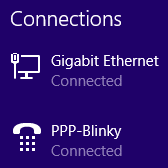
A Windows desktop showing PPP-Blinky in the network connections list.
Describe PPP-Blinky in Three Sentences
PPP-Blinky is a tiny library that enables Internet protocols (IPv4) to any mbed target hardware by using only a serial port.
The code runs on processors with as little as 8k RAM, for example the Nucleo-L053R8 board.
PPP-Blinky uses the industry-standard PPP (Point-to-Point) Protocol and a tiny "stateless" TCP/IP stack.
No Ethernet Port Required
No ethernet port is required - PPP-Blinky uses a serial port to send IP packets to your PC.
PPP-Blinky emulates a standard dial-up modem and therefore connects to Windows, Linux or Adroid machines.
The code runs on most ARM mbed platforms such as the LPC11U24 shown in the picture below:
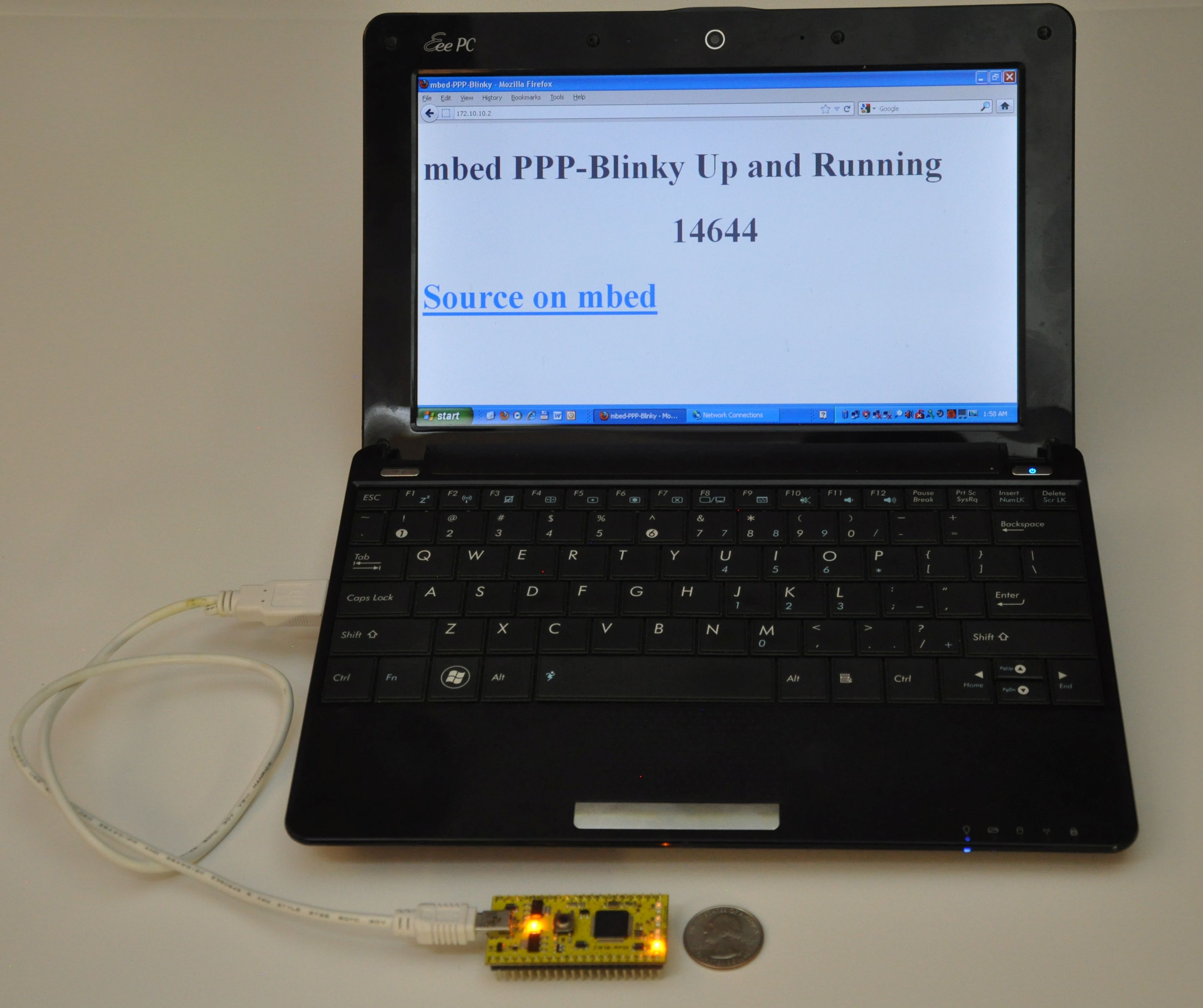 mbed LPC11u24 acting as a webserver to a Windows laptop.
mbed LPC11u24 acting as a webserver to a Windows laptop.
Webserver
The Webserver and WebSocket functions are ideal for building browser-based GUIs on mbed-enabled hardware.
PPP-Blinky's HTTP webserver works with most web clients such as Internet Explorer, Mozilla Firefox, Google Chrome, Safari, Curl, wget and Lynx as well as Microsoft Powershell Invoke-Webrequest command.
In the image below Firefox web browser displays the main web page embedded into PPP-Blinky's code:
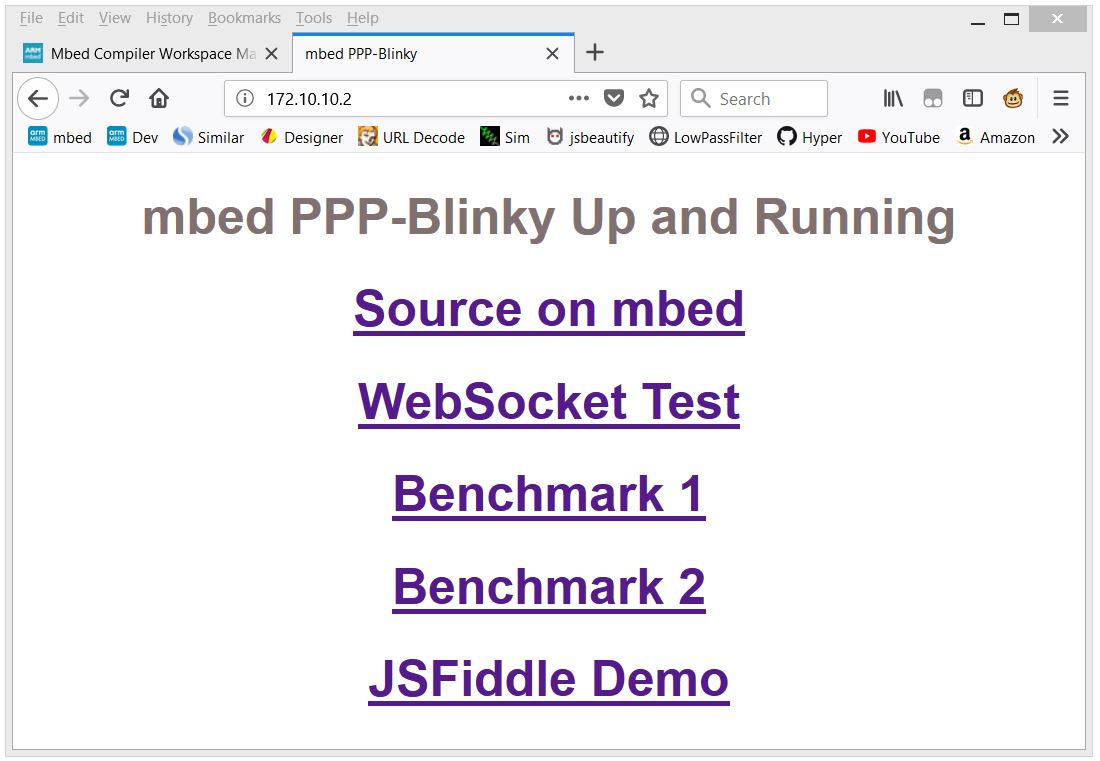 Firefox web browser displays a web page embedded into PPP-Blinky's code
Firefox web browser displays a web page embedded into PPP-Blinky's code
WebSocket Service
WebSocket is the most popular protocol standard for real-time bidirectional TCP/IP communication between clients and servers.
In the image below a small Internet Explorer script has connected to PPP-Blinky's WebSocket Service.
A websocket message was then sent by the browser and was echoed back by the WebSocket, triggering the onmessage event in the script.
The WebSocket service enables bidirectional real-time interaction between PPP-Blinky and any element in the browser DOM via JavaScript.
If you already have PPP-Blinky up and running you can test your WebSocket service using this: http://jsfiddle.net/d26cyuh2/112/embedded/result
Websockets are ideal for building browser-based GUIs for mbed hardware.
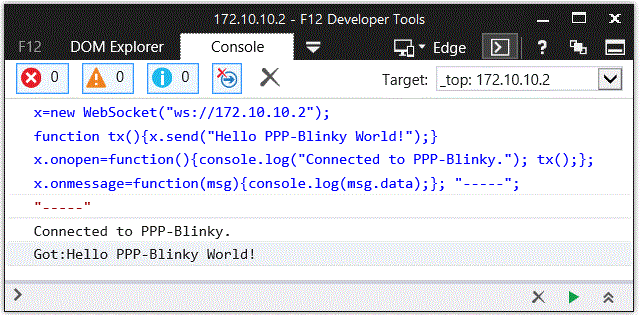
Trying PPP-Blinky on your mbed board
You will need an mbed-enabled hardware board: https://developer.mbed.org/platforms/
Establish a serial port connection between your host PC and your mbed board.
The easiest way is to use mbed hardware with a USB serial debug port. I've tried the ST-Micro Nucleo-L476RG, Nucleo-L152RE, Nucleo-F401RE, Nucleo-L432KC, Nucleo-L053R8, mbed-LPC11U24 and mbed-LPC1768 boards and they all work out of the box. Use the mbed online compiler to compile the software for your target board. Save the compiled binary to your hardware.
Before establishing a network connection, you can verify the operation of the code by opening a terminal program such as Tera Term, and setting the baud rate of the COM port on your mbed board to 115200 baud. LED1 should toggle for every two 0x7E (~) (i.e. tilde) characters you type, as 0x7E is the PPP frame start/end marker. Don't forget to close the port when your'e done testing, or else Windows Dial-up Networking will report that the COM port is in use by another program when you try to connect.
Once you are certain that the serial port and firmware is working, proceed to creating a new network connection on your PC -see below.
Creating a Dial-up Connection in Windows

Setting up Dial-Up Networking (DUN) on your Windows 7 or 8 PC is essentially a two-step process: First, you create a new modem device, because PPP-blinky partially emulates a standard Windows serial port modem device. Second, you create a new Internet connection (in practice, a new network adapter) which is associated with your new "modem".
Step-by-step description of how to configure Windows for PPP-Blinky here:
/users/nixnax/code/PPP-Blinky/wiki/Configuring-Windows-Dial-Up-Networking
There is also a screen on how to set up Linux dial-up networking near the bottom of this page.
Connecting to PPP-Blinky from your PC
Once Windows networking is configured you can establish a dial-up connection to your mbed board over the USB virtual com port.
The IP address you manually assigned to the new dial-up network adapter (172.10.10.1) functions as a gateway to any valid IP address on that subnet. In the screen capture below, I'm sending pings from the Windows 8 command line to my ST-Micro Nucleo-L476RG board over the USB virtual serial Port. I'm also using a second serial port and Tera Term to capture the debug output from a second serial port on the hardware. The optional debug output from the board prints out the IP source and destination address and the first few bytes of the data payload. Note that the source is the adapter IP address, (172.10.10.1 in this case) and the destination is some other address on that subnet - all packets to the subnet are sent to our mbed hardware. For example, you could also ping 172.10.10.123 or, if your PPP-Blinky is running, simply click on this link: http://172.10.10.123
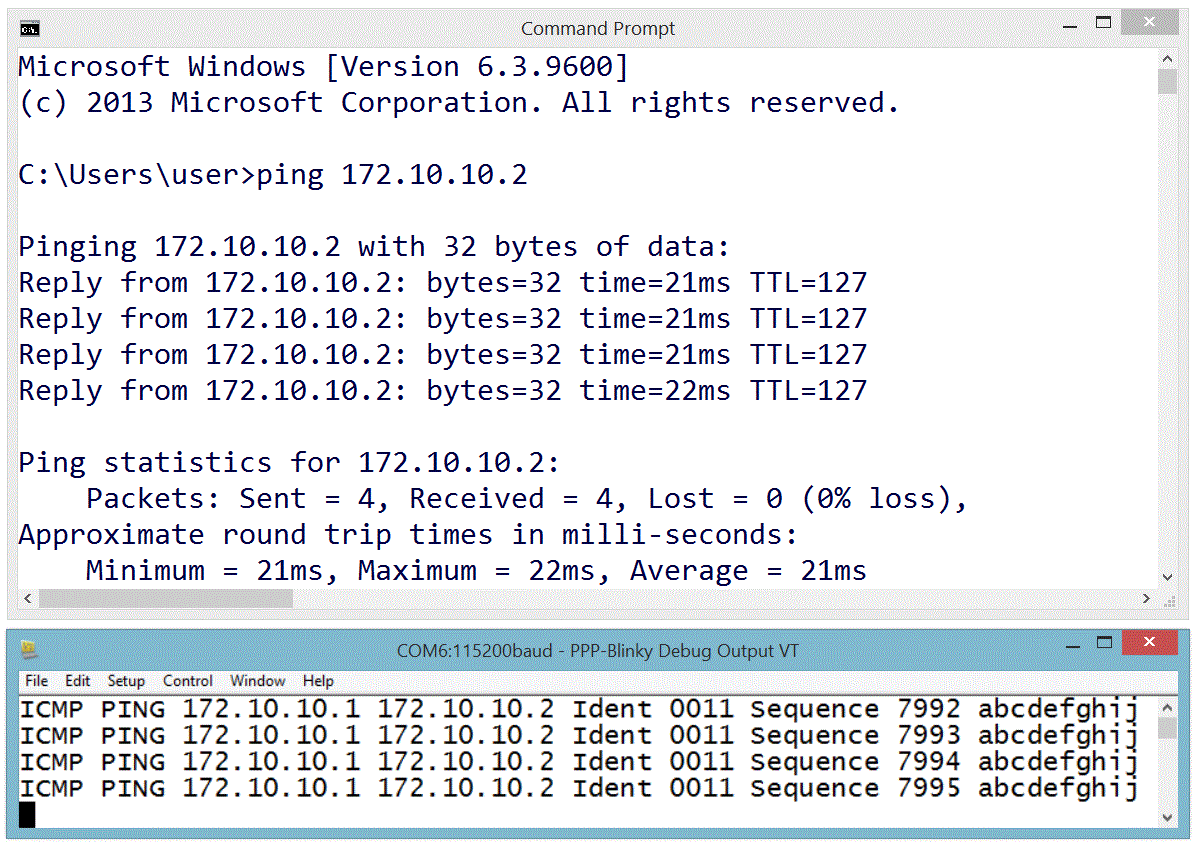
One Million Pings!
In the image below the ICMP ("ping") echo reply service was tested by sending one million pings to ppp-Blinky. This took over two hours.
The ping tool used on the Windows 8 PC was psping.exe from PsTools by Mark Russinovich - http://bit.ly/PingFast
The average reply time for a short ping (1 byte of payload data) was 11 milliseconds at 115200 baud on the $10 Nucleo-L053R8 board - barely enough time for 130 bytes to be sent over the port!
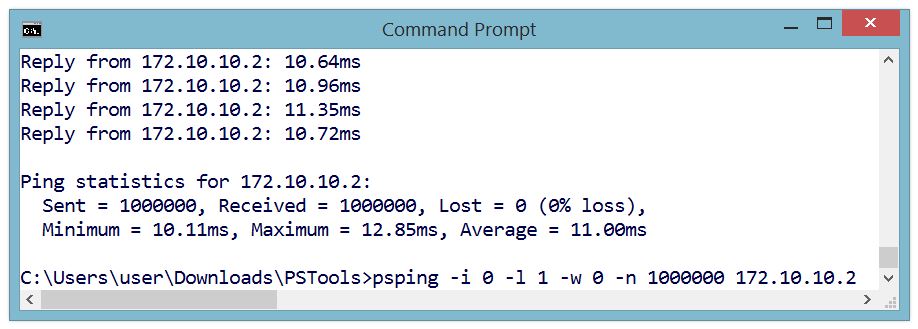
Monitoring PPP-Blinky Packets
The image below is from a Microsoft Network Monitor 3.4 capture session.
Responses from PPP-Blinky are shown in blue.
Frame 2 - Internet Explorer at IP 172.10.10.1 (the Dial-Up Adapter IP) requests a TCP connection by sending an S (SYN) flag.
Frame 3 - PPP-Blinky at IP 172.10.10.2 responds with an ACK in frame 3. One direction of the link is now established.
Frame 4 - The PC acknowledges the SYN sent by PPP-Blinky in frame 3. The TCP link is now fully established.
Frame 5 - The browser "pushes" (P flag is set) an HTTP GET request to PPP-Blinky.
Frame 6 - PPP-Blinky responds with a standard HTTP response "pushes" (P flag set) back a small web page. It also sets the A (ACK) flag to acknowledge the message sent in frame 6.
Frame 7 - The PC acknowledges reception of the HTTP payload.
Frame 8 - The PC starts to shut down the TCP connection by sending a FIN flag.
Frame 9 - PPP-Blinky acknowledges the FIN request - the connection is now closed in one direction. It also sets a FIN flag in the response to request closure of the opposite direction of the connection.
Frame 10 - The PC acknowledges the FIN request. The closing of the TCP connection is now confirmed in both directions.
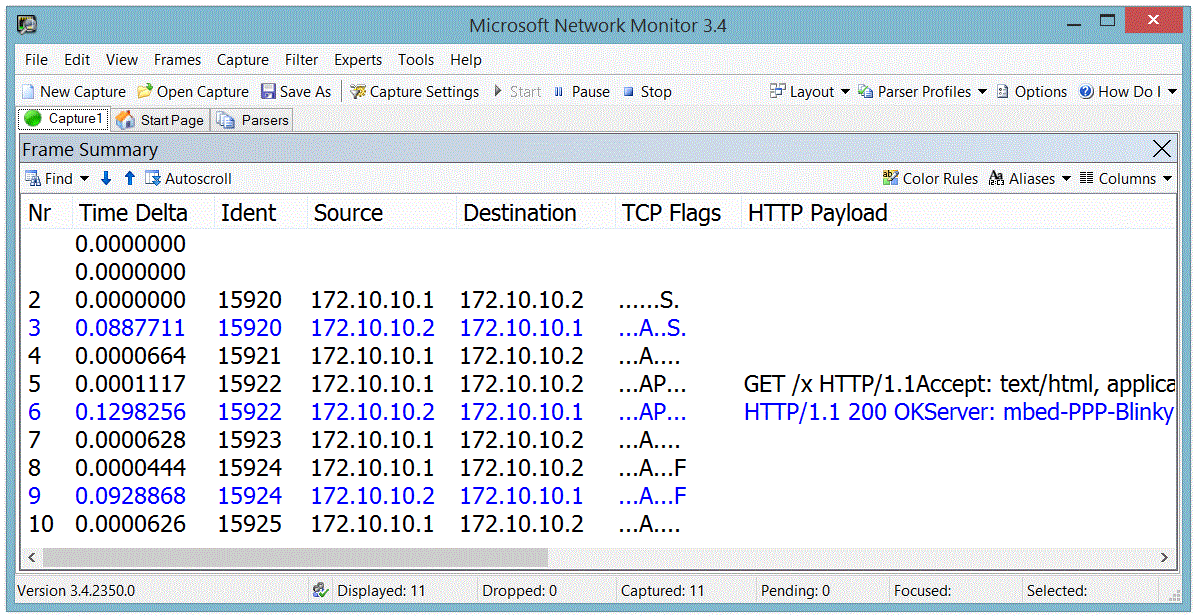
Debug Output
PPP-Blinky can output handy debug information to an optional second serial port.
The image below shows the debug output (Ident, Source, Destination, TCP Flags) for a complete HTTP conversation.
The PC messages are displayed in black. PPP-Blinky messages are blue.
Notice how PPP-blinky automatically inserts a blank line after each full HTTP conversation.
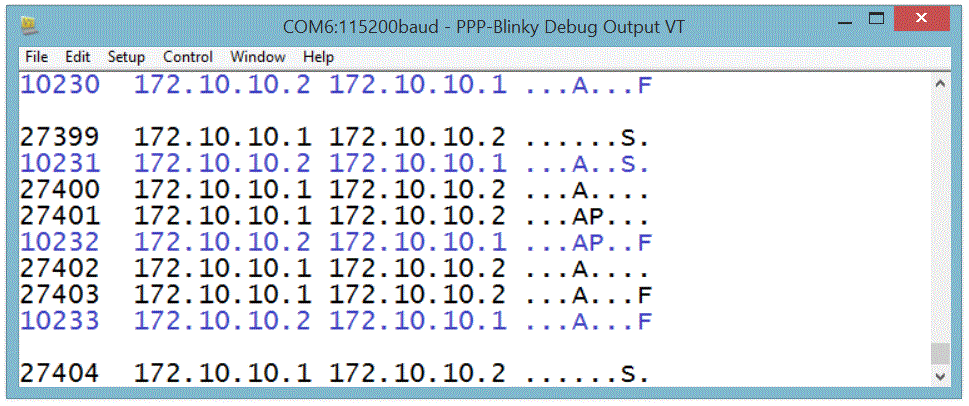
Creating a Dial-Up Connection in Linux
The screen below shows the required pppd command to connect to PPP-Blinky from a Linux machine. This was much simpler than Windows! The USB serial port of the mbed LPC1768 board registered as /dev/ttyACM0 on my Linux box. Do a websearch on pppd if you want to learn more about pppd, the Linux PPP handler. Near the bottom of the screen below, two webpages are fetched (/ and /y) by using the curl command on the command line. Gnome Webkit and Firefox work fine, too. Also try echo GET / HTTP/1.1 | nc 172.10.10.2 which uses netcat, the "Swiss army knife" of networking tools. PPP-Blinky was also tested with ApacheBench, the Apache server benchmark software. After 100000 fetches, the mean page fetch rate was reported as 6 page fetches per second for a small page.
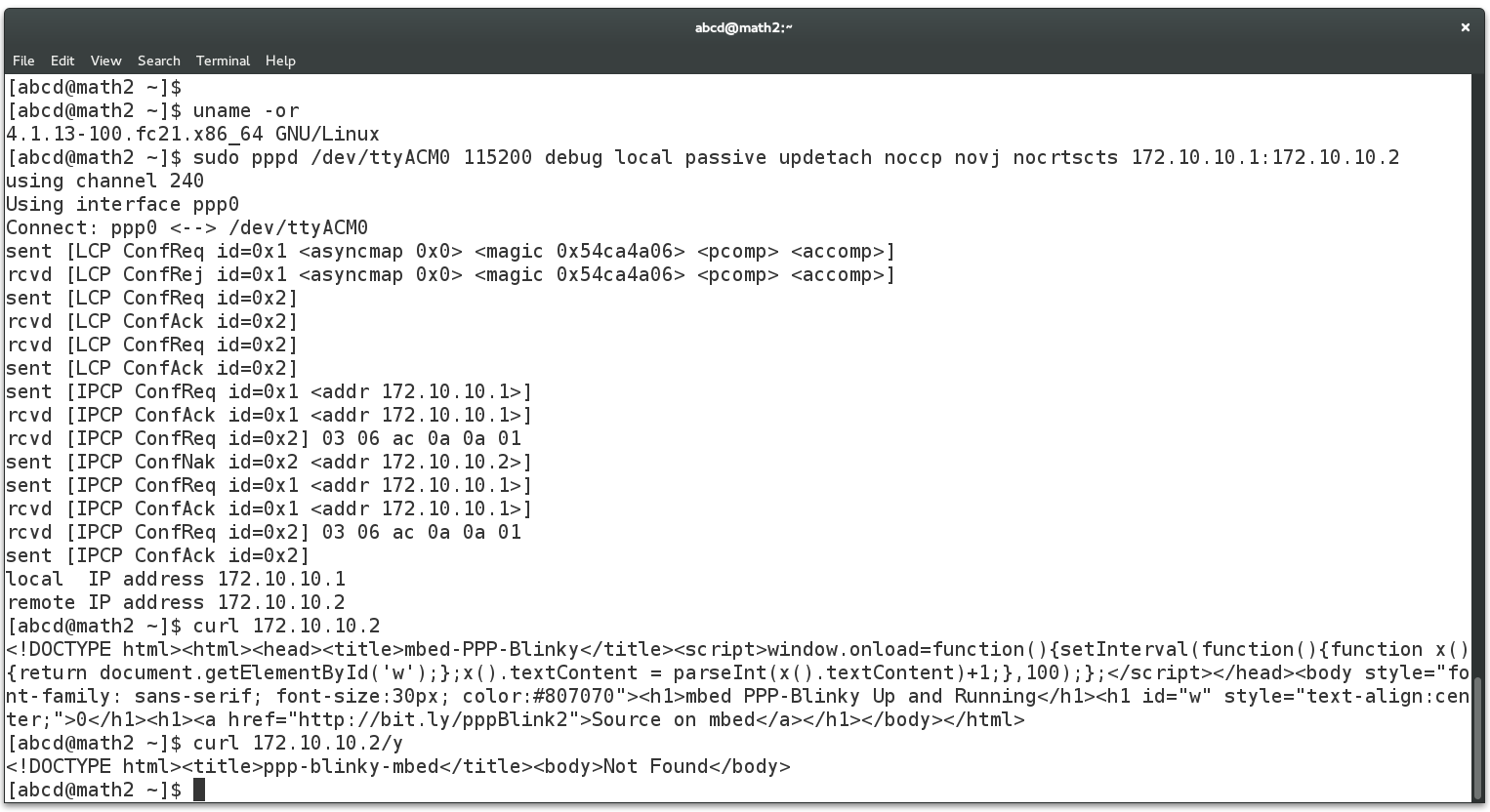
Caveats
PPP Blinky is an extremely sparse implementation (1.5k lines) of HTTP,WebSocket,TCP, UDP, ICMP, IPCP and LCP over PPP, requiring around 8kB of RAM. The minimum functionality required to establish connectivity is implemented. These are often acceptable tradeoffs for embedded projects as well as a handy tool to learn the practical details of everyday networking implementations.
PPP-Blinky/ppp-blinky.cpp
- Committer:
- nixnax
- Date:
- 2017-09-25
- Revision:
- 186:7ff62f1c1a16
- Parent:
- 185:4cd8f91e9d49
- Child:
- 193:48072570f41d
File content as of revision 186:7ff62f1c1a16:
// PPP-Blinky - "The Most Basic Internet Thing"
// A Tiny HTTP Webserver Using Windows XP/7/8/10/Linux Dial-Up Networking Over A Serial Port.
// Receives UDP packets and responds to ping (ICMP Echo requests)
// WebSocket Service - see https://en.wikipedia.org/wiki/WebSocket
// Copyright 2016/2017 Nicolas Nackel aka Nixnax. Permission is hereby granted, free of charge, to any person obtaining a copy of this software and associated documentation files (the "Software"), to deal in the Software without restriction, including without limitation the rights to use, copy, modify, merge, publish, distribute, sublicense, and/or sell copies of the Software, and to permit persons to whom the Software is furnished to do so, subject to the following conditions: The above copyright notice and this permission notice shall be included in all copies or substantial portions of the Software. THE SOFTWARE IS PROVIDED "AS IS", WITHOUT WARRANTY OF ANY KIND, EXPRESS OR IMPLIED, INCLUDING BUT NOT LIMITED TO THE WARRANTIES OF MERCHANTABILITY, FITNESS FOR A PARTICULAR PURPOSE AND NONINFRINGEMENT. IN NO EVENT SHALL THE AUTHORS OR COPYRIGHT HOLDERS BE LIABLE FOR ANY CLAIM, DAMAGES OR OTHER LIABILITY, WHETHER IN AN ACTION OF CONTRACT, TORT OR OTHERWISE, ARISING FROM, OUT OF OR IN CONNECTION WITH THE SOFTWARE OR THE USE OR OTHER DEALINGS IN THE SOFTWARE.
// Notes and Instructions
// http://bit.ly/PPP-Blinky-Instructions
// http://bit.ly/win-rasdial-config
// Handy reading material
// https://technet.microsoft.com/en-us/library/cc957992.aspx
// https://en.wikibooks.org/wiki/Serial_Programming/IP_Over_Serial_Connections
// http://atari.kensclassics.org/wcomlog.htm
// Handy tools
// https://ttssh2.osdn.jp/index.html.en - Tera Term, a good terminal program to monitor the debug output from the second serial port with!
// https://www.microsoft.com/en-us/download/details.aspx?id=4865 - Microsoft network monitor - real-time monitoring of PPP packets
// http://pingtester.net/ - nice tool for high rate ping testing
// http://www.sunshine2k.de/coding/javascript/crc/crc_js.html - Correctly calculates the 16-bit FCS (crc) on our frames (Choose CRC16_CCITT_FALSE), then custom relected-in=1, reflected-out=1
// https://technet.microsoft.com/en-us/sysinternals/pstools.aspx - psping for fast testing of ICMP ping function
// https://eternallybored.org/misc/netcat/ - use netcat -u 172.10.10.1 80 to send/receive UDP packets from PPP-Blinky
// Windows Powershell invoke-webrequest command - use it to stress test the webserver like this: while (1){ invoke-webrequest -uri 172.10.10.1/x }
// Connecting PPP-Blinky to Linux
// PPP-Blinky can be made to talk to Linux - tested on Fedora - the following command, which uses pppd, works:
// pppd /dev/ttyACM0 115200 debug dump local passive noccp novj nodetach nocrtscts 172.10.10.1:172.10.10.2
// in the above command 172.10.10.1 is the adapter IP, and 172.10.10.2 is the IP of PPP-Blinky.
// See also https://en.wikipedia.org/wiki/Point-to-Point_Protocol_daemon
// Special pages when PPP-Blinky is running
// 172.10.10.2 root page
// 172.10.10.2/x returns the number of ppp frames sent - this is handy for testing
// 172.10.10.2/xb also returns number of ppp frames sent, but issues a fast refresh meta command. This allows you to use your browser to benchmark page load speed
// 172.10.10.2/ws a simple WebSocket demo
// http://jsfiddle.net/d26cyuh2/ more complete WebSocket demo in JSFiddle, showing cross-domain access
// Ok, enough talking, time to check out some code!!
#include "ppp-blinky.h"
// The #define below enables/disables a second (OPTIONAL) serial port that prints out interesting diagnostic messages.
// Change to SERIAL_PORT_MONITOR_YES to enable diagnostics messages. You need to wire a second serial port to your mbed hardware to monitor the debug output.
// Using the second serial port will slow down packet response time
// Note - the LPC11U24 does NOT have a second serial port
#define SERIAL_PORT_MONITOR_NO /* change to SERIAL_PORT_MONITOR_YES for debug messages */
// here we define the OPTIONAL, second debug serial port for various mbed target boards
#ifdef SERIAL_PORT_MONITOR_YES
#if defined(TARGET_LPC1768)
RawSerial xx(p9, p10); // Second serial port on LPC1768 - not required to run, if you get compile error here, change #define SERIAL_PORT_MONITOR_YES to #define SERIAL_PORT_MONITOR_NO
#elif defined(TARGET_NUCLEO_F446RE) || defined(TARGET_NUCLEO_L152RE) || defined(TARGET_NUCLEO_L053R8) || defined(TARGET_NUCLEO_L476RG) || defined(TARGET_NUCLEO_F401RE)
RawSerial xx(PC_10, PC_11); // Second serial port on NUCLEO boards - not required to run, if you get compile error here, change #define SERIAL_PORT_MONITOR_YES to #define SERIAL_PORT_MONITOR_NO
#elif defined(TARGET_LPC11U24)
#error The LPC11U24 does not have a second serial port to use for debugging - change SERIAL_PORT_MONITOR_YES back to SERIAL_PORT_MONITOR_NO
#elif defined (TARGET_KL46Z) || (TARGET_KL25Z)
RawSerial xx(PTE0,PTE1); // Second serial port on FRDM-KL46Z board
#elif defined(YOUR_TARGET_BOARD_NAME_HERE)
// change the next line to YOUR target board's second serial port pin definition if it's not present - and if it works, please send it to me - thanks!!!
RawSerial xx(p9, p10); // change this to YOUR board second serial port pin definition - and please send it to me if it works!!!
#else
#error Add your target board's second serial port here if you want to use debugging - or simply change SERIAL_PORT_MONITOR_YES to SERIAL_PORT_MONITOR_NO
#endif
#define debugPrintf(x...) xx.printf (x) /* if we have a serial port we can print debug messages */
#define debugPutc(x...) xx.putc(x)
#define debugBaudRate(x...) xx.baud(x)
#else
// if we don't have a debug port the debug print functions do nothing
#define debugPrintf(x...) {}
#define debugPutc(x...) {}
#define debugBaudRate(x...) {}
#endif
// verbosity flags used in debug printouts - change to 1 to see increasingly more detailed debug info.
#define v0 1
#define v1 0
#define v2 0
#define IP_HEADER_DUMP_YES /* YES for ip header dump */
#define TCP_HEADER_DUMP_YES /* YES for tcp header dump */
// this is the webpage we serve when we get an HTTP request to root (/)
// keep size under ~900 bytes to fit into a single PPP packet
const static char rootWebPage[] = "\
<!DOCTYPE html>\
<html>\
<head>\
<title>mbed PPP-Blinky</title>\r\n\
<script>\r\n\
window.onload=function(){\
setInterval(function(){function x(){return document.getElementById('w');};\
x().textContent=parseInt(x().textContent)+1;},100);};\r\n\
</script>\r\n\
</head>\
<body style=\"font-family: sans-serif; font-size:20px; text-align:center; color:#807070\">\
<h1>mbed PPP-Blinky Up and Running</h1>\
<h1 id=\"w\">0</h1>\
<h1><a href=\"http://bit.ly/pppBlink2\">Source on mbed</a></h1>\
<h1><a href=\"/ws\">WebSocket Demo</a></h1>\
<h1><a href=\"/x\">Benchmark 1</a></h1>\
<h1><a href=\"/xb\">Benchmark 2</a></h1>\
<h1><a href=\"http://jsfiddle.net/d26cyuh2/\">JSFiddle Demo</a></h1>\
</body>\
</html>\r\n"; // size = 644 bytes plus 1 null byte = 645 bytes
// this is a websocket demo html page we serve when GET /ws is requested
const static char webSocketPage[] = "\
<!DOCTYPE html>\
<html>\
<head>\
<title>mbed PPP-Blinky</title>\
<script>\
window.onload=function(){\
var url=\"ws://172.10.10.2\";\
var sts=document.getElementById(\"sts\");\
var btn=document.getElementById(\"btn\");\
var ctr=0;\
function show(text){sts.textContent=text;}\
btn.onclick=function(){\
if(btn.textContent==\"Connect\"){\
x=new WebSocket(url);\
x.onopen=function(){\
show(\"Connected to : \"+url);\
btn.textContent=\"Send \\\"\"+ctr+\"\\\"\";\
};\
x.onclose=function(){show(\"closed\");};\
x.onmessage=function(msg){show(\"PPP-Blinky Sent: \\\"\"+msg.data+\"\\\"\");};\
} else {\
x.send(ctr);\
ctr=ctr+1;\
btn.textContent=\"Send \\\"\"+ctr+\"\\\"\";\
}\
};\
};\
</script>\
<body style=\"font-family: sans-serif; font-size:25px; color:#807070\">\
<h1>PPP-Blinky WebSocket Test</h1>\
<div id=\"sts\">Idle</div>\
<button id=\"btn\" style=\"font-size: 100%; margin-top: 55px; margin-bottom: 55px;\">Connect</button>\
<h4><a href=\"/\">PPP-Blinky home</a></h4>\
</body>\
</html>"; // size = 916 bytes + 1 null byte = 917 bytes
// The serial port on your mbed hardware. Your PC should be configured to view this port as a standard dial-up networking modem.
// On Windows the model type of the modem should be selected as "Communications cable between two computers"
// The modem baud rate should be set to 115200 baud
// See instructions at the top.
// On a typical mbed hardware platform this serial port is a USB virtual com port (VCP) and the USB serial driver is supplied by the board vendor.
RawSerial pc (USBTX, USBRX); // usb virtual com port for mbed hardware
DigitalOut led1(LED1); // this led toggles when a packet is received
// the standard hdlc frame start/end character. It's the tilde character "~"
#define FRAME_7E (0x7e)
pppType ppp; // our global - definitely not thread safe
/// Initialize the ppp structure and clear the receive buffer
void pppInitStruct()
{
memset( ppp.rx.buf, 0, RXBUFLEN);
ppp.online=0;
ppp.rx.tail=0;
ppp.rx.rtail=0;
ppp.rx.head=0;
ppp.rx.buflevel=0;
ppp.pkt.len=0;
ppp.ipData.ident=10000; // easy to recognize in ip packet dumps
ppp.ledState=0;
ppp.hdlc.frameStartIndex=0;
ppp.responseCounter=0;
ppp.firstFrame=1;
ppp.ppp = (pppHeaderType *)ppp.pkt.buf; // pointer to ppp header
ppp.ip = (ipHeaderType *)(ppp.pkt.buf+4); // pointer to IP header
}
/// Toggle the LED on every second PPP packet received
void led1Toggle()
{
led1 = (ppp.ledState >> 1) & 1; // use second bit, in other words toggle LED only every second packet
ppp.ledState++;
}
/// Returns 1 after a connect message, 0 at startup or after a disconnect message
int connectedPpp()
{
return ppp.online;
}
/// Previously used to check for characters in receive buffer.
/// Now just a stub.
void checkPc() {};
/// PPP serial port receive interrupt handler.
/// Check for available characters from the PC and read them into our own circular serial receive buffer at ppp.rx.buf.
/// Also, if we are offline and a 0x7e frame start character is seen, we go online immediately
void pppReceiveHandler()
{
char ch;
while ( pc.readable() ) {
int hd = (ppp.rx.head+1)&(RXBUFLEN-1); // increment/wrap head index
if ( hd == ppp.rx.rtail ) {
debugPrintf("\nReceive buffer full\n");
return;
}
ch = pc.getc(); // read new character
ppp.rx.buf[ppp.rx.head] = ch; // insert in our receive buffer
if ( ppp.online == 0 ) {
if (ch == 0x7E) {
ppp.online = 1;
}
}
ppp.rx.head = hd; // update head pointer
ppp.rx.buflevel++;
}
}
/// print to debug port while checking for incoming characters
void putcWhileCheckingInput( char outByte )
{
#ifdef SERIAL_PORT_MONITOR_YES
checkPc();
debugPutc( outByte );
checkPc();
#endif
}
/// puts to debug port while checking the PPP input stream
void putsWhileCheckingInput( char * data )
{
#ifdef SERIAL_PORT_MONITOR_YES
char * nextChar = data;
while( *nextChar != 0 ) {
putcWhileCheckingInput( *nextChar ); // write one character to debug port while checking input
nextChar++;
}
#endif
}
/// Initialize the PPP FCS (frame check sequence) total
void fcsReset()
{
ppp.fcs=0xffff; // crc restart
}
/// update the cumulative PPP FCS (frame check sequence)
void fcsDo(int x)
{
for (int i=0; i<8; i++) {
ppp.fcs=((ppp.fcs&1)^(x&1))?(ppp.fcs>>1)^0x8408:ppp.fcs>>1; // crc calculator
x>>=1;
}
checkPc(); // handle input
}
/// calculate the PPP FCS (frame check sequence) on an entire block of memory
int fcsBuf(char * buf, int size) // crc on an entire block of memory
{
fcsReset();
for(int i=0; i<size; i++)fcsDo(*buf++);
return ppp.fcs;
}
/// Get one character from our received PPP buffer
int pc_getBuf()
{
int x = ppp.rx.buf[ ppp.rx.tail ];
ppp.rx.tail=(ppp.rx.tail+1)&(RXBUFLEN-1);
ppp.rx.buflevel--;
return x;
}
/// Dump a PPP frame to the debug serial port
/// Note - the hex output of dumpPPPFrame() can be imported into WireShark
/// Capture the frame's hex output in your terminal program and save as a text file
/// In WireShark, use "Import Hex File". Import options are: Offset=None, Protocol=PPP.
void dumpPPPFrame()
{
char pbuf[30];
for(int i=0; i<ppp.pkt.len; i++) {
checkPc();
sprintf(pbuf, "%02x ", ppp.pkt.buf[i]);
checkPc();
putsWhileCheckingInput(pbuf);
}
checkPc();
sprintf(pbuf, " CRC=%04x Len=%d\n", ppp.pkt.crc, ppp.pkt.len);
checkPc();
putsWhileCheckingInput(pbuf);
}
/// Process a received PPP frame
void processPPPFrame(int start, int end)
{
led1Toggle(); // change led1 state on every frame we receive
if(start==end) {
return; // empty frame
}
fcsReset();
char * dest = ppp.pkt.buf;
ppp.pkt.len=0;
int unstuff=0;
int idx = start;
while(1) {
checkPc();
if (unstuff==0) {
if (ppp.rx.buf[idx]==0x7d) unstuff=1;
else {
*dest = ppp.rx.buf[idx];
ppp.pkt.len++;
dest++;
fcsDo(ppp.rx.buf[idx]);
}
} else { // unstuff characters prefixed with 0x7d
*dest = ppp.rx.buf[idx]^0x20;
ppp.pkt.len++;
dest++;
fcsDo(ppp.rx.buf[idx]^0x20);
unstuff=0;
}
idx = (idx+1) & (RXBUFLEN-1);
if (idx == end) break;
}
ppp.pkt.crc = ppp.fcs & 0xffff;
if(0) dumpPPPFrame(); // set to 1 to dump ALL ppp frames
if (ppp.pkt.crc == 0xf0b8) { // check for good CRC
determinePacketType();
} else {
#define REPORT_FCS_ERROR_YES
#ifdef REPORT_FCS_ERROR_YES
char pbuf[50]; // local print buffer
checkPc();
sprintf(pbuf, "\nPPP FCS(crc) Error CRC=%x Length = %d\n",ppp.pkt.crc,ppp.pkt.len); // print a debug line
checkPc();
putsWhileCheckingInput( pbuf );
if(0) dumpPPPFrame(); // set to 1 to dump frames with errors in them
#endif
}
}
/// output a character to the PPP port while checking for incoming characters
void pcPutcWhileCheckingInput(int ch)
{
checkPc(); // check input
pc.putc(ch);
checkPc();
}
/// do PPP HDLC-like handling of special (flag) characters
void hdlcPut(int ch)
{
if ( (ch<0x20) || (ch==0x7d) || (ch==0x7e) ) {
pcPutcWhileCheckingInput(0x7d);
pcPutcWhileCheckingInput(ch^0x20); // these characters need special handling
} else {
pcPutcWhileCheckingInput(ch);
}
}
/// send a PPP frame in HDLC format
void sendPppFrame()
{
ppp.responseCounter++; // count the number of ppp frames we send
int crc = fcsBuf(ppp.pkt.buf, ppp.pkt.len-2); // update crc
ppp.pkt.buf[ ppp.pkt.len-2 ] = (~crc>>0); // fcs lo (crc)
ppp.pkt.buf[ ppp.pkt.len-1 ] = (~crc>>8); // fcs hi (crc)
pcPutcWhileCheckingInput(0x7e); // hdlc start-of-frame "flag"
for(int i=0; i<ppp.pkt.len; i++) {
wait_us(86); // wait one character time
checkPc();
hdlcPut( ppp.pkt.buf[i] ); // send a character
}
pcPutcWhileCheckingInput(0x7e); // hdlc end-of-frame "flag"
}
/// convert a network ip address in the buffer to an integer (IP adresses are big-endian, i.e most significant byte first)
int bufferToIP(char * buffer)
{
int result=0;
for(int i=0; i<4; i++) result = (result<<8)|(*buffer++ & 0xff);
return result;
}
/// convert 4-byte ip address to 32-bit
unsigned int ip( int a, int b, int c, int d)
{
return a<<24 | b<<16 | c<<8 | d;
}
/// handle IPCP configuration requests
void ipcpConfigRequestHandler()
{
debugPrintf("Their IPCP Config Req, Our Ack\n");
if(ppp.ipcp->request[0]==3) {
ppp.hostIP = bufferToIP(ppp.pkt.buf+10);
debugPrintf("Host IP = %d.%d.%d.%d (%08x)\n", ppp.ipcp->request[2],ppp.ipcp->request[3],ppp.ipcp->request[4],ppp.ipcp->request[5],ppp.hostIP);
}
ppp.ipcp->code=2; // change code to ack
sendPppFrame(); // acknowledge everything they ask for - assume it's IP addresses
debugPrintf("Our IPCP Ask (no options)\n");
ppp.ipcp->code=1; // change code to request
ppp.ipcp->lengthR = __REV16( 4 ); // 4 is minimum length - no options in this request
ppp.pkt.len=4+4+2; // no options in this request shortest ipcp packet possible (4 ppp + 4 ipcp + 2 crc)
sendPppFrame(); // send our request
}
/// handle IPCP acknowledge (do nothing)
void ipcpAckHandler()
{
debugPrintf("Their IPCP Grant\n");
}
/// Handle IPCP NACK by sending our suggested IP address if there is an IP involved.
/// This is how Linux responds to an IPCP request with no options - Windows assumes any IP address on the submnet is OK.
void ipcpNackHandler()
{
debugPrintf("Their IPCP Nack\n");
if (ppp.ipcp->request[0]==3) { // check if the NACK contains an IP address parameter
ppp.ipcp->code=1; // assume the NACK contains our "suggested" IP address
sendPppFrame(); // let's request this IP address as ours
debugPrintf("Our IPCP ACK (received an IP)\n");
} else { // if it's not an IP nack we ignore it
debugPrintf("IPCP Nack Ignored\n");
}
}
/// handle all other IPCP requests (by ignoring them)
void ipcpDefaultHandler()
{
debugPrintf("Their IPCP Other\n");
}
/// process an incoming IPCP packet
void IPCPframe()
{
int action = ppp.ipcp->code; // packet type is here
switch (action) {
case 1:
ipcpConfigRequestHandler();
break;
case 2:
ipcpAckHandler();
break;
case 3:
ipcpNackHandler();
break;
default:
ipcpDefaultHandler();
}
}
/// perform a 16-bit checksum. if the byte count is odd, stuff in an extra zero byte.
unsigned int dataCheckSum(char * ptr, int len, int restart)
{
unsigned int i,hi,lo;
unsigned char placeHolder;
if (restart) ppp.sum=0;
if (len&1) {
placeHolder = ptr[len];
ptr[len]=0; // if the byte count is odd, insert one extra zero byte is after the last real byte because we sum byte PAIRS
}
i=0;
while ( i<len ) {
checkPc();
hi = ptr[i++];
lo = ptr[i++];
ppp.sum = ppp.sum + ((hi<<8)|lo);
}
if (len&1) {
ptr[len] = placeHolder; // restore the extra byte we made zero
}
ppp.sum = (ppp.sum & 0xffff) + (ppp.sum>>16);
ppp.sum = (ppp.sum & 0xffff) + (ppp.sum>>16); // sum one more time to catch any carry from the carry
return ~ppp.sum;
}
/// perform the checksum on an IP header
void IpHeaderCheckSum()
{
ppp.ip->checksumR=0; // zero the checsum in the IP header
int len = 4 * ppp.ip->headerLength; // length of IP header in bytes
unsigned int sum = dataCheckSum(ppp.ipStart,len,1);
ppp.ip->checksumR = __REV16( sum ); // insert fresh checksum
}
/// swap the IP source and destination addresses
void swapIpAddresses()
{
unsigned int tempHold;
tempHold = ppp.ip->srcAdrR; // tempHold <- source IP
ppp.ip->srcAdrR = ppp.ip->dstAdrR; // source <- dest
ppp.ip->dstAdrR = tempHold; // dest <- tempHold*/
}
/// swap the IP source and destination ports
void swapIpPorts()
{
int headerSizeIP = 4 * (ppp.ip->headerLength); // calculate size of IP header
char * ipSrcPort = ppp.ipStart + headerSizeIP + 0; // ip source port location
char * ipDstPort = ppp.ipStart + headerSizeIP + 2; // ip destin port location
char tempHold[2];
memcpy(tempHold, ipSrcPort,2); // tempHold <- source
memcpy(ipSrcPort,ipDstPort,2); // source <- dest
memcpy(ipDstPort,tempHold, 2); // dest <- tempHold
}
/// Build the "pseudo header" required for UDP and TCP, then calculate its checksum
void checkSumPseudoHeader( unsigned int packetLength )
{
// this header contains the most important parts of the IP header, i.e. source and destination address, protocol number and data length.
pseudoIpHeaderType pseudoHeader; // create pseudo header
pseudoHeader.srcAdrR = ppp.ip->srcAdrR; // copy in ip source address
pseudoHeader.dstAdrR = ppp.ip->dstAdrR; // copy in ip dest address
pseudoHeader.zero = 0; // zero byte
pseudoHeader.protocol = ppp.ip->protocol; // protocol number (udp or tcp)
pseudoHeader.lengthR = __REV16( packetLength ); // size of tcp or udp packet
dataCheckSum(pseudoHeader.start, 12, 1); // calculate this header's checksum
}
/// initialize an IP packet to send
void initIP (unsigned int srcIp, unsigned int dstIp, unsigned int srcPort, unsigned int dstPort, unsigned int protocol)
{
ppp.ppp->address = 0xff;
ppp.ppp->control = 3;
ppp.ppp->protocolR = __REV16( 0x0021 );
ppp.ip->version = 4;
ppp.ip->headerLength = 5; // 5 words = 20 bytes
ppp.ip->identR = __REV16(ppp.ipData.ident++); // insert our ident
ppp.ip->dontFragment=1;
ppp.ip->ttl=128;
ppp.ip->protocol = protocol; // udp
ppp.ip->srcAdrR = __REV(srcIp);
ppp.ip->dstAdrR = __REV(dstIp);
ppp.udpStart = ppp.ipStart + 20; // calculate start of udp header
ppp.udp->srcPortR = __REV16(srcPort); // source port
ppp.udp->dstPortR = __REV16(dstPort); // dest port
}
/// Build a UDP packet from scratch
void sendUdp(unsigned int srcIp, unsigned int dstIp, unsigned int srcPort, unsigned int dstPort, char * message,int msgLen)
{
struct {
unsigned int ipAll; // length of entire ip packet
unsigned int ipHeader; // length of ip header
unsigned int udpAll; // length of entire udp packet
unsigned int udpData; // length of udp data segment
} len;
len.ipHeader = 20; // ip header length
len.udpData = msgLen; // udp data size
len.udpAll = len.udpData+8; // update local udp packet length
len.ipAll = len.ipHeader + len.udpAll; // update IP Length
initIP(srcIp, dstIp, srcPort, dstPort, 17); // init a UDP packet
ppp.ip->lengthR = __REV16(len.ipAll); // update IP length in buffer
ppp.udpStart = ppp.ipStart + len.ipHeader; // calculate start of udp header
memcpy( ppp.udp->data, message, len.udpData ); // copy the message to the buffer
ppp.udp->lengthR = __REV16(len.udpAll); // update UDP length in buffer
ppp.pkt.len = len.ipAll+2+4; // update ppp packet length
IpHeaderCheckSum(); // refresh IP header checksum
checkSumPseudoHeader( len.udpAll ); // get the UDP pseudo-header checksum
ppp.udp->checksumR = 0; // before TCP checksum calculations the checksum bytes must be set cleared
unsigned int pseudoHeaderSum=dataCheckSum(ppp.udpStart,len.udpAll, 0); // continue the TCP checksum on the whole TCP packet
ppp.udp->checksumR = __REV16( pseudoHeaderSum); // tcp checksum done, store it in the TCP header
sendPppFrame(); // send the UDP message back
}
/// Process an incoming UDP packet.
/// If the packet starts with the string "echo " or "test" we echo back a special packet
void UDPpacket()
{
struct {
unsigned int all; // length of entire ip packet
unsigned int header; // length of ip header
} ipLength;
struct {
unsigned int all; // length of entire udp packet
unsigned int data; // length of udp data segment
} udpLength;
ipLength.header = 4 * ppp.ip->headerLength; // length of ip header
ppp.udpStart = ppp.ipStart + ipLength.header; // calculate start of udp header
udpLength.all = __REV16( ppp.udp->lengthR ); // size of udp packet
udpLength.data = udpLength.all - 8; // size of udp data
#ifdef SERIAL_PORT_MONITOR_YES
char * srcIP = ppp.ip->srcAdrPtr; // IP source
char * dstIP = ppp.ip->dstAdrPtr; //IP destination
unsigned int udpSrcPort = __REV16( ppp.udp->srcPortR ); // integer of UDP source port
unsigned int udpDstPort = __REV16( ppp.udp->dstPortR ); // integer of UDP dest port
if(v0) {
debugPrintf("UDP %d.%d.%d.%d:%d ", srcIP[0],srcIP[1],srcIP[2],srcIP[3],udpSrcPort);
debugPrintf("%d.%d.%d.%d:%d ", dstIP[0],dstIP[1],dstIP[2],dstIP[3],udpDstPort);
debugPrintf("Len %03d", udpLength);
}
if (v1) {
int printSize = udpLength.data;
if (printSize > 20) printSize = 20; // print only first 20 characters
for (int i=0; i<printSize; i++) {
char ch = ppp.udp->data[i];
if (ch>31 && ch<127) {
debugPrintf("%c", ch);
} else {
debugPrintf("_");
}
}
}
if (v0) debugPrintf("\n");
#endif
int echoFound = !strncmp(ppp.udp->data,"echo ",5); // true if UDP message starts with "echo "
int testFound = !strncmp(ppp.udp->data,"test" ,4); // true if UDP message starts with "test"
if ( (echoFound) || (testFound)) { // if the UDP message starts with "echo " or "test" we answer back
if (echoFound) {
swapIpAddresses(); // swap IP source and destination
swapIpPorts(); // swap IP source and destination ports
memcpy(ppp.udp->data,"Got{",4); // in the UDP data modify "echo" to "Got:"
int n=0;
n=n+sprintf(n+ppp.udp->data+udpLength.data, "} UDP Server: PPP-Blinky\n"); // an appendix
udpLength.data = udpLength.data + n; // update udp data size with the size of the appendix
// we may have changed data length, update all the lengths
udpLength.all = udpLength.data+8; // update local udp packet length
ipLength.all = ipLength.header + udpLength.all; // update IP Length
ppp.ip->lengthR = __REV16(ipLength.all); // update IP length in buffer
ppp.udp->lengthR = __REV16(udpLength.all); // update UDP length in buffer
ppp.pkt.len = ipLength.all+2+4; // update ppp packet length
IpHeaderCheckSum(); // refresh IP header checksum
checkSumPseudoHeader( udpLength.all ); // get the UDP pseudo-header checksum
ppp.udp->checksumR = 0; // before TCP checksum calculations the checksum bytes must be set cleared
unsigned int pseudoHeaderSum=dataCheckSum(ppp.udpStart,udpLength.all, 0); // continue the TCP checksum on the whole TCP packet
ppp.udp->checksumR = __REV16( pseudoHeaderSum); // tcp checksum done, store it in the TCP header
sendPppFrame(); // send the UDP message back
} else if ( testFound ) {
unsigned int sI = __REV( ppp.ip->srcAdrR );
unsigned int dI = __REV( ppp.ip->dstAdrR );
unsigned int sp = __REV16( ppp.udp->srcPortR );
unsigned int dp = __REV16( ppp.udp->dstPortR );
int n=sprintf(ppp.pkt.buf+200,"Response Count %d\n", ppp.responseCounter);
sendUdp(dI,sI,dp,sp,ppp.pkt.buf+200,n); // build a udp packet from the ground up
}
}
}
/// UDP demo that sends a udp packet containing a character received from the second debug serial port.
/// Sends a 48 byte IP/UDP header for every 1 byte of data so line-mode would probably be better.
/// If you want ip packets from ppp blinky to be routed to other networks, ensure you have ip routing enabled.
/// See http://www.wikihow.com/Enable-IP-Routing.
/// Also ensure that the firewall on the receiving machine has the receiving UDP port (12345 in this example) enabled.
/// The netcat UDP receive command on the remote host would be: nc -ul 12345
void sendUdpData()
{
#ifdef SERIAL_PORT_MONITOR_YES
if (ppp.online) {
if (xx.readable()) {
char inchar = xx.getc();
xx.putc( inchar ); // echo the received character on the debug serial port
sendUdp(ip(172,10,10,2), ip(192,168,0,109), 1, 12345, &inchar, 1); // send a 1 byte UDP message to a remote machine at IP 192.168.0.109:12345
}
}
#endif
}
/// handle a PING ICMP (internet control message protocol) packet
void ICMPpacket() // internet control message protocol
{
struct {
unsigned int all; // length of entire ip packet
unsigned int header; // length of ip header
} ipLength;
struct {
unsigned int all; // length of entire udp packet
unsigned int data; // length of udp data segment
} icmpLength;
ipLength.all = __REV16( ppp.ip->lengthR ); // length of ip packet
ipLength.header = 4 * ppp.ip->headerLength; // length of ip header
ppp.icmpStart = ppp.ipStart + ipLength.header; // calculate start of udp header
icmpLength.all = ipLength.all - ipLength.header; // length of icmp packet
icmpLength.data = icmpLength.all - 8; // length of icmp data
#define ICMP_TYPE_PING_REQUEST 8
if ( ppp.icmp->type == ICMP_TYPE_PING_REQUEST ) {
ppp.ip->ttl--; // decrement time to live (so we have to update header checksum)
#ifdef SERIAL_PORT_MONITOR_YES
char * srcAdr = ppp.ip->srcAdrPtr;
char * dstAdr = ppp.ip->dstAdrPtr;
int icmpIdent = __REV16( ppp.ip->identR ); // byte reversed - big endian
int icmpSequence = __REV16( ppp.icmp->sequenceR ); // byte reversed - big endian
if(1) {
char pbuf[50];
checkPc();
sprintf(pbuf, "ICMP PING %d.%d.%d.%d %d.%d.%d.%d ", srcAdr[0],srcAdr[1],srcAdr[2],srcAdr[3],dstAdr[0],dstAdr[1],dstAdr[2],dstAdr[3]);
putsWhileCheckingInput( pbuf );
checkPc();
sprintf(pbuf, "Ident %04x Sequence %04d \n",icmpIdent,icmpSequence);
checkPc();
putsWhileCheckingInput( pbuf );
}
#endif
swapIpAddresses(); // swap the IP source and destination addresses
IpHeaderCheckSum(); // new ip header checksum (required because we changed TTL)
#define ICMP_TYPE_ECHO_REPLY 0
ppp.icmp->type = ICMP_TYPE_ECHO_REPLY; // icmp echo reply
ppp.icmp->checkSumR = 0; // zero the checksum for recalculation
unsigned int sum = dataCheckSum(ppp.icmpStart, icmpLength.all, 1); // icmp checksum
ppp.icmp->checkSumR = __REV16( sum ); // save big-endian icmp checksum
int printSize = icmpLength.data; // exclude size of icmp header
if (printSize > 10) printSize = 10; // print up to 20 characters
if (0) {
for (int i=0; i<printSize; i++) {
char ch = ppp.icmp->data[i];
if (ch>31 && ch<127) {
putcWhileCheckingInput(ch);
} else {
putcWhileCheckingInput('_');
}
}
putcWhileCheckingInput('\n');
}
sendPppFrame(); // reply to the ping
} else {
if (v0) {
debugPrintf("ICMP type=%x \n", ppp.icmp->type);
}
}
}
/// handle an IGMP (internet group managment protocol) packet (by ignoring it)
void IGMPpacket()
{
if (v0) debugPrintf("IGMP type=%d \n", ppp.pkt.buf[28]);
}
/// dump the header of an IP pakcet on the (optional) debug serial port
void dumpHeaderIP (int outGoing)
{
#if defined(IP_HEADER_DUMP_YES) && defined(SERIAL_PORT_MONITOR_YES)
checkPc(); // we are expecting the first character of the next packet
int IPv4Id = __REV16(ppp.ip->identR);
char pbuf[80]; // local print buffer
int n=0;
n=n+sprintf(pbuf+n, outGoing ? "\x1b[34m" : "\x1b[30m" ); // VT100 color code, print black for incoming, blue for outgoing headers
n=n+sprintf(pbuf+n, "%05d ",IPv4Id); // IPv4Id is a good way to correlate our dumps with net monitor or wireshark traces
#define DUMP_FULL_IP_ADDRESS_YES
#ifdef DUMP_FULL_IP_ADDRESS_YES
char * srcAdr = ppp.ip->srcAdrPtr;
char * dstAdr = ppp.ip->dstAdrPtr;
n=n+sprintf(pbuf+n, " %d.%d.%d.%d %d.%d.%d.%d ",srcAdr[0],srcAdr[1],srcAdr[2],srcAdr[3], dstAdr[0],dstAdr[1],dstAdr[2],dstAdr[3]); // full ip addresses
#endif
putsWhileCheckingInput( pbuf );
#ifndef TCP_HEADER_DUMP_YES
putsWhileCheckingInput('\x1b[30m\n'); // if there's no TCP header dump we terminate the line with \n and VT100 code for black
#endif
#endif
}
/// dump a TCP header on the optional debug serial port
void dumpHeaderTCP(int outGoing)
{
#if defined(TCP_HEADER_DUMP_YES) && defined(SERIAL_PORT_MONITOR_YES)
char flagString[9]; // text string presenting the 8 most important TCP flags
#define PRINT_ALL_TCP_FLAGS_YES
#ifdef PRINT_ALL_TCP_FLAGS_YES
memset(flagString,'.', 8); // fill string with "........"
if (ppp.tcp->flag.fin) flagString[7]='F';
if (ppp.tcp->flag.syn) flagString[6]='S';
if (ppp.tcp->flag.rst) flagString[5]='R';
if (ppp.tcp->flag.psh) flagString[4]='P';
if (ppp.tcp->flag.ack) flagString[3]='A';
if (ppp.tcp->flag.urg) flagString[2]='U';
if (ppp.tcp->flag.ece) flagString[1]='E';
if (ppp.tcp->flag.cwr) flagString[0]='C';
flagString[8]=0; // null terminate string
#else
if (ppp.tcp->flag.ack) flagString[0]='A'; // choose only the most important flag to print
if (ppp.tcp->flag.syn) flagString[0]='S';
if (ppp.tcp->flag.fin) flagString[0]='F';
if (ppp.tcp->flag.psh) flagString[0]='P';
if (ppp.tcp->flag.rst) flagString[0]='R';
flagString[1]=0; // null terminate string
#endif
putsWhileCheckingInput( flagString );
#define EVERY_PACKET_ON_A_NEW_LINE_YES
#ifdef EVERY_PACKET_ON_A_NEW_LINE_YES
putsWhileCheckingInput("\x1b[30m\n"); // write a black color and newline after every packet
#else
putsWhileCheckingInput("\x1b[30m"); // write a black color after every packet
#endif
if( outGoing && ppp.tcp->flag.fin ) { // ACK/FIN - if this is an outgoing FIN it's the end of a tcp conversation
putcWhileCheckingInput('\n'); // insert an extra new line to mark the end (except for final ack) of an HTTP conversation
}
#endif
}
/// Encode a buffer in base-64
const static char lut [] = "ABCDEFGHIJKLMNOPQRSTUVWXYZabcdefghijklmnopqrstuvwxyz0123456789+/=";
void enc64(char * in, char * out, int len)
{
int i,j,a,b,c;
i=0;
j=0;
while(1) {
if (i<len) {
a = in[i++];
out[j++] = lut[ ( (a >> 2) & 0x3f) ];
} else break;
if (i<len) {
b = in[i++];
out[j++] = lut[ ( (a << 4) & 0x30) | ( (b >> 4) & 0x0f) ];
out[j++] = lut[ ( (b << 2) & 0x3c) ];
} else out[j++] = '=';
if (i<len) {
c = in[i++];
j--;
out[j++] = lut[ ( (b << 2) & 0x3c) | ( (c >> 6) & 0x03) ];
out[j++] = lut[ ( (c >> 0) & 0x3f) ];
} else out[j++] = '=';
}
out[j]=0;
}
/// Handle a request for an http websocket.
/// We end up here if we enter the following javascript in a web browser console: x = new WebSocket("ws://172.10.10.2");
int webSocketHandler(char * dataStart)
{
int n=0; // byte counter
char * key = strstr(dataStart, "Sec-WebSocket-Key:"); // search for the key in the payload
if (key != NULL) {
key = key + 18; // skip over the key ident string "Sec-WebSocket-Key:"
if (v0) putsWhileCheckingInput("WebSocket Request\n");
while ( strchr(lut, *key) == NULL) key++; // skip non-valid base-64 characters (whitespace)
char challenge [80];
int i=0;
char * copyTo = challenge;
while (strchr(lut, *key) != NULL) { // copy while we see valid base-64 characters
if (i++ >40) break; // prevent buffer overflow
*copyTo++ = *key++; // copy next valid base-64 character
}
strcpy(copyTo,"258EAFA5-E914-47DA-95CA-C5AB0DC85B11"); // append websocket gui code
if (0) debugPrintf("Challenge is %s\n", challenge); // the string we hash for the challenge
char shaOutput [20]; // sha1 output
sha1( shaOutput, challenge, strlen(challenge)); // hash the challenge
char encOut[50];
enc64( shaOutput, encOut, 20); // base-64 encode
char * versionstring = strstr(dataStart, "Sec-WebSocket-Version:");
char * version = challenge;
strncpy(version, versionstring,70); // copy their version string
*strchr(version,'\r')=0; // null terminate so we can sprintf it
memset(dataStart,0,500); // blank out old data befor send the websocket response header
n=n+sprintf(dataStart+n, "HTTP/1.1 101 Switching Protocols\r\n");
n=n+sprintf(dataStart+n, "Upgrade: websocket\r\n");
n=n+sprintf(dataStart+n, "Connection: Upgrade\r\n");
n=n+sprintf(dataStart+n, "Sec-WebSocket-Accept: %s\r\n",encOut);
n=n+sprintf(dataStart+n, "%s\r\n",version);
n=n+sprintf(dataStart+n, "mbed-Code: PPP-Blinky\r\n");
n=n+sprintf(dataStart+n, "\r\n"); // websocket response header ending
}
return n; // this response should satisfy a web browser's websocket protocol request
}
#define TCP_FLAG_ACK (1<<4)
#define TCP_FLAG_SYN (1<<1)
#define TCP_FLAG_PSH (1<<3)
#define TCP_FLAG_RST (1<<2)
#define TCP_FLAG_FIN (1<<0)
/// respond to an HTTP request
int httpResponse(char * dataStart, int * flags)
{
int n=0; // number of bytes we have printed so far
n = webSocketHandler( dataStart ); // test for and handle WebSocket upgrade requests
if (n>0) return n; // if n>0 we already have a response, so return
int nHeader; // byte size of HTTP header
int contentLengthStart; // index where HTML starts
int httpGet5,httpGet6,httpGetx, httpGetRoot; // temporary storage of strncmp results
*flags = TCP_FLAG_ACK | TCP_FLAG_FIN; // the default case is that we close the connection
httpGetRoot = strncmp(dataStart, "GET / HTTP/1.", 13); // found a GET to the root directory
httpGetx = strncmp(dataStart, "GET /x", 6); // found a GET to /x which we will treat special (anything starting with /x, e.g. /x, /xyz, /xABC?pqr=123
httpGet5 = dataStart[5]; // the first character in the path name, we use it for special functions later on
httpGet6 = dataStart[6]; // the second character in the path name, we use it for special functions later on
// for example, you could try this using netcat (nc): echo "GET /x" | nc 172.10.10.2
if( (httpGetRoot==0) || (httpGetx==0) ) {
n=n+sprintf(n+dataStart,"HTTP/1.1 200 OK\r\nServer: mbed-PPP-Blinky-v1\r\n"); // 200 OK header
} else {
n=n+sprintf(n+dataStart,"HTTP/1.1 404 Not Found\r\nServer: mbed-PPP-Blinky\r\n"); // 404 header
}
n=n+sprintf(n+dataStart,"Content-Length: "); // http header
contentLengthStart = n; // remember where Content-Length is in buffer
n=n+sprintf(n+dataStart,"?????\r\n"); // leave five spaces for content length - will be updated later
n=n+sprintf(n+dataStart,"Connection: close\r\n"); // close connection immediately
n=n+sprintf(n+dataStart,"Content-Type: text/html; charset=us-ascii\r\n\r\n"); // http header must end with empty line (\r\n)
nHeader=n; // size of HTTP header
if( httpGetRoot == 0 ) {
// this is where we insert our web page into the buffer
memcpy(n+dataStart,rootWebPage,sizeof(rootWebPage));
n = n + sizeof(rootWebPage)-1; // one less than sizeof because we don't count the null byte at the end
} else if ( (httpGet5 == 'w') && (httpGet6 == 's') ) { // "ws" is a special page for websocket demo
memcpy(n+dataStart,webSocketPage,sizeof(webSocketPage));
n = n + sizeof(webSocketPage)-1; // one less than size
*flags = TCP_FLAG_ACK | TCP_FLAG_PSH; // for a websocket page we do NOT close the connection
} else {
if (httpGetx == 0) { // the page request started with "GET /x" - here we treat anything starting with /x special:
#define W3C_COMPLIANT_RESPONSE_NO
// change the above to W3C_COMPLIANT_RESPONSE_YES if you want a W3C.org compliant HTTP response
#ifdef W3C_COMPLIANT_RESPONSE_YES
n=n+sprintf(n+dataStart,"<!DOCTYPE html><title>mbed PPP-Blinky</title>"); // html title (W3C.org required elements)
n=n+sprintf(n+dataStart,"<body>%d</body>",ppp.responseCounter); // body = the http frame count
#else
if( httpGet6 == 'b' ) { // if the fetched page is "xb" send a meta command to let the browser continuously reload
n=n+sprintf(n+dataStart, "<meta http-equiv=\"refresh\" content=\"0\">"); // reload loop - handy for benchmarking
}
// /x is a very short page, in fact, it is only a decimal number showing the http Page count
n=n+sprintf(n+dataStart,"%d ",ppp.responseCounter); // not really valid html but most browsers and curl are ok with it
#endif
} else {
// all other requests get 404 Not Found response with a http frame count - nice for debugging
n=n+sprintf(n+dataStart,"<!DOCTYPE html><title>mbed PPP-Blinky</title>"); // html title (required element)
n=n+sprintf(n+dataStart,"<body>Not Found</body>"); // not found message
}
}
#define CONTENTLENGTHSIZE 5
char contentLengthString[CONTENTLENGTHSIZE+1];
snprintf(contentLengthString,CONTENTLENGTHSIZE+1,"%*d",CONTENTLENGTHSIZE,n-nHeader); // print Content-Length with leading spaces and fixed width equal to csize
memcpy(dataStart+contentLengthStart, contentLengthString, CONTENTLENGTHSIZE); // copy Content-Length to it's place in the send buffer
return n; // total byte size of our response
}
/// Handle TCP data that is not an HTTP GET.
/// This is handy when for example you want to use netcat (nc.exe) to talk to PPP-Blinky.
/// This could also be a websocket receive event - especially if the first byte is 0x81 (websocket data push)
int tcpResponse(char * dataStart, int len, int * outFlags)
{
int n=0; // number of bytes we have printed so far
if (dataStart[0] == 0x81) { // check if this is a websocket push message
char mask [4];
memcpy ( mask, dataStart+2, 4); // websocket messages are "masked", so first we obtain the 4-byte mask
int websocketMessageSize = len - 6; // 1 byte prefix (0x81), 1 byte, 4 bytes mask = 6 bytes
if((dataStart[1]&0x80)==0x80) // test if the mask bit is set, which means all data is xor'ed with the mask
for (int i=0; i<websocketMessageSize; i++) dataStart[i+6]^= mask[i%4]; // unmask each byte with one of the mask bytes
dataStart[1] = len-2; // add four extra bytes to the message length because we don't use mask bytes for the send
memcpy(dataStart+2, "Got:",4); // insert our own text into the four mask bytes
n = len; // our response size remains exactly the same length as what we received
} else if ( (dataStart[0]==0x88) && (dataStart[1]==0x80) && (len == 6) ) { // test for a websocket close request
n=2; // our close command is only two bytes long because we don't use the four mask bytes
dataStart[1]=0; // we don't have mask bytes on
} else {
if ( len > 1 ) { // we assume a length of 1 is a keep-alive or push packet
if (v1) putsWhileCheckingInput("TCP data received\n"); // all other tcp push packets
}
}
return n; // total byte size of our response
}
/// dump the TCP data to the debug serial port
void dumpDataTCP(int outGoing)
{
#ifdef SERIAL_PORT_MONITOR_YES
if (v2) {
int packetLengthIp = __REV16(ppp.ip->lengthR ); // size of ip packet
int headerSizeIp = 4 * ppp.ip->headerLength; // size of ip header
ppp.tcpStart = ppp.ipStart + headerSizeIp; // calculate where the TCP header starts
int headerSizeTcp = 4 * (ppp.tcp->offset); // tcp "offset" for start of data is also the header size
ppp.tcpData = ppp.tcpStart + headerSizeTcp; // start of tcp data
int tcpSize = packetLengthIp - headerSizeIp; // tcp size = size of ip payload
int tcpDataSize = tcpSize - headerSizeTcp; // size of data block after TCP header
char pbuf[80]; // local print buffer
int n=0;
checkPc();
n=n+sprintf(pbuf+n, outGoing ? "\x1b[34m" : "\x1b[30m" ); // VT100 color code, print black for incoming, blue for outgoing headers
checkPc();
n=n+sprintf(pbuf+n, "IP:%d ipHeader:%d tcpHeader:%d tcpData:%d\n", packetLengthIp, headerSizeIp, headerSizeTcp, tcpDataSize); // 1 for more verbose
if (n>70) putsWhileCheckingInput("n>pbuf overflow in dumpDataTCP()\n");
checkPc();
putsWhileCheckingInput( pbuf );
if (tcpDataSize > 0) {
ppp.tcpData[tcpDataSize]=0; // insert a null after the data so debug printf stops printing after the data
putsWhileCheckingInput( ppp.tcpData ); // print the tcp payload data
putsWhileCheckingInput("\n");
}
putsWhileCheckingInput( "\x1b[30m" ); // VT100 color code, print black
}
#endif
}
/// handle an incoming TCP packet
/// use the first few bytes to figure out if it's a websocket, an http request or just pure incoming TCP data
void tcpHandler()
{
int packetLengthIp = __REV16(ppp.ip->lengthR ); // size of ip packet
int headerSizeIp = 4 * ppp.ip->headerLength; // size of ip header
ppp.tcpStart = ppp.ipStart + headerSizeIp; // calculate TCP header start
int tcpSize = packetLengthIp - headerSizeIp; // tcp size = size of ip payload
int headerSizeTcp = 4 * (ppp.tcp->offset); // tcp "offset" for start of data is also the header size
char * tcpDataIn = ppp.tcpStart + headerSizeTcp; // start of data TCP data after TCP header
int tcpDataSize = tcpSize - headerSizeTcp; // size of data block after TCP header
unsigned int seq_in = __REV(ppp.tcp->seqTcpR);
unsigned int ack_in = __REV(ppp.tcp->ackTcpR);
unsigned int ack_out = seq_in + tcpDataSize;
unsigned int seq_out = ack_in; // use their version of our current sequence number
// first we shorten the TCP response header to only 20 bytes. This means we ignore all TCP option requests
headerSizeIp=20;
ppp.ip->headerLength = headerSizeIp/4; // ip header is 20 bytes long
ppp.ip->lengthR = __REV(40); // 20 ip header + 20 tcp header
//tcpSize = 20; // shorten total TCP packet size to 20 bytes (no data)
headerSizeTcp = 20; // shorten outgoing TCP header size 20 bytes
ppp.tcpStart = ppp.ipStart + headerSizeIp; // recalc TCP header start
ppp.tcp->offset = (headerSizeTcp/4);
char * tcpDataOut = ppp.tcpStart + headerSizeTcp; // start of outgoing data
int dataLen = 0; // most of our responses will have zero TCP data, only a header
int flagsOut = TCP_FLAG_ACK; // the default case is an ACK packet
ppp.tcp->windowR = __REV16( 1200 ); // set tcp window size to 1200 bytes
// A sparse TCP flag interpreter that implements stateless TCP connections
switch ( ppp.tcp->flag.All ) {
case TCP_FLAG_SYN:
flagsOut = TCP_FLAG_SYN | TCP_FLAG_ACK; // something wants to connect - acknowledge it
seq_out = seq_in+0x10000000U; // create a new sequence number using their sequence as a starting point, increase the highest digit
ack_out++; // for SYN flag we have to increase the sequence by 1
break;
case TCP_FLAG_ACK:
case TCP_FLAG_ACK | TCP_FLAG_PSH:
if ( (ppp.tcp->flag.All == TCP_FLAG_ACK) && (tcpDataSize == 0)) return; // handle zero-size ack messages by ignoring them
if ( (strncmp(tcpDataIn, "GET /", 5) == 0) ) { // check for an http GET command
flagsOut = TCP_FLAG_ACK | TCP_FLAG_PSH; // we have data, set the PSH flag
dataLen = httpResponse(tcpDataOut, &flagsOut); // send an http response
} else {
dataLen = tcpResponse(tcpDataOut,tcpDataSize, &flagsOut); // not an http GET, handle as a tcp connection
if (dataLen > 0) flagsOut = TCP_FLAG_ACK | TCP_FLAG_PSH; // if we have any data set the PSH flag
}
break;
case TCP_FLAG_FIN:
case TCP_FLAG_FIN | TCP_FLAG_ACK:
case TCP_FLAG_FIN | TCP_FLAG_PSH | TCP_FLAG_ACK:
flagsOut = TCP_FLAG_ACK | TCP_FLAG_FIN; // set outgoing FIN flag to ask them to close from their side
ack_out++; // for FIN flag we have to increase the sequence by 1
break;
default:
return; // ignore all other packets
} // switch
// The TCP flag handling is now done
// first we swap source and destination TCP addresses and insert the new ack and seq numbers
swapIpAddresses(); // swap IP source and destination addresses
swapIpPorts(); // swap IP source and destination ports
ppp.tcp->ackTcpR = __REV( ack_out ); // byte reversed - tcp/ip messages are big-endian (high byte first)
ppp.tcp->seqTcpR = __REV( seq_out ); // byte reversed - tcp/ip messages are big-endian (high byte first)
ppp.tcp->flag.All = flagsOut; // update the TCP flags
// recalculate all the header sizes
tcpSize = headerSizeTcp + dataLen; // tcp packet size
int newPacketSize = headerSizeIp + tcpSize; // calculate size of the outgoing packet
ppp.ip->lengthR = __REV16 ( newPacketSize );
ppp.pkt.len = newPacketSize+4+2; // ip packet length + 4-byte ppp prefix (ff 03 00 21) + 2 fcs (crc) bytes bytes at the end of the packet
// the header is all set up, now do the IP and TCP checksums
IpHeaderCheckSum(); // calculate new IP header checksum
checkSumPseudoHeader( tcpSize ); // get the TCP pseudo-header checksum
ppp.tcp->checksumR = 0; // before TCP checksum calculations the checksum bytes must be set cleared
unsigned int pseudoHeaderSum=dataCheckSum(ppp.tcpStart,tcpSize, 0); // continue the TCP checksum on the whole TCP packet
ppp.tcp->checksumR = __REV16( pseudoHeaderSum); // tcp checksum done, store it in the TCP header
dumpHeaderIP(1); // dump outgoing IP header before sending the frame
dumpHeaderTCP(1); // dump outgoing TCP header before sending the frame
dumpDataTCP(1); // dump outgoing TCP data before sending the frame
if (0) wait_ms(45); // 45 ms delay before sending frame - a typical internet delay time
sendPppFrame(); // All preparation complete - send the TCP response
if(0) dumpPPPFrame(); // set to 1 to dump transmitted ppp frame
memset(ppp.pkt.buf+44,0,500); // flush out traces of previous data that we may scan for
}
/// handle an incoming TCP packet
void TCPpacket()
{
dumpHeaderIP(0); // dump incoming packet IP header
dumpHeaderTCP(0); // dump incoming packet TCP header
dumpDataTCP(0); // dump incoming packet data
tcpHandler();
}
/// handle the remaining IP protocols by ignoring them
void otherProtocol()
{
debugPrintf("Other IP protocol");
}
/// process an incoming IP packet
void IPframe()
{
int protocol = ppp.ip->protocol;
switch (protocol) {
case 1:
ICMPpacket();
break;
case 2:
IGMPpacket();
break;
case 17:
UDPpacket();
break;
case 6:
TCPpacket();
break;
default:
otherProtocol();
}
}
/// respond to LCP (line configuration protocol) configuration request) by allowing no options
void LCPconfReq()
{
debugPrintf("LCP Config ");
if ( ppp.lcp->lengthR != __REV16(4) ) {
ppp.lcp->code=4; // allow only "no options" which means Maximum Receive Unit (MRU) is default 1500 bytes
debugPrintf("Reject\n");
sendPppFrame();
} else {
ppp.lcp->code=2; // ack zero conf
debugPrintf("Ack\n");
sendPppFrame();
debugPrintf("LCP Ask\n");
ppp.lcp->code=1; // request no options
sendPppFrame();
}
}
/// handle LCP acknowledge packets by ignoring them
void LCPconfAck()
{
debugPrintf("LCP Ack\n");
}
/// handle LCP end (disconnect) packets by acknowledging them and by setting ppp.online to false
void LCPend()
{
ppp.lcp->code=6; // end
sendPppFrame(); // acknowledge
ppp.online=0; // start hunting for connect string again
pppInitStruct(); // flush the receive buffer
debugPrintf("LCP End (Disconnect from host)\n");
}
/// respond to other LCP requests by ignoring them
void LCPother()
{
debugPrintf("LCP Other\n");
dumpPPPFrame();
}
/// process incoming LCP packets
void LCPframe()
{
int code = ppp.lcp->code;
switch (code) {
case 1:
LCPconfReq();
break; // config request
case 2:
LCPconfAck();
break; // config ack
case 5:
LCPend();
break; // end connection
default:
LCPother();
}
}
/// discard packets that are not IP, IPCP, or LCP
void discardedFrame()
{
if (v0) debugPrintf("Frame is not IP, IPCP or LCP: %02x %02x %02x %02x\n", ppp.pkt.buf[0],ppp.pkt.buf[1],ppp.pkt.buf[2],ppp.pkt.buf[3]);
}
/// determine the packet type (IP, IPCP or LCP) of incoming packets
void determinePacketType()
{
if ( ppp.ppp->address != 0xff ) {
debugPrintf("Unexpected: PPP address != ff\n");
return;
}
if ( ppp.ppp->control != 3 ) {
debugPrintf("Unexpected: PPP control != 3\n");
return;
}
unsigned int protocol = __REV16( ppp.ppp->protocolR );
switch ( protocol ) {
case 0xc021:
LCPframe();
break; // link control
case 0x8021:
IPCPframe();
break; // IP control
case 0x0021:
IPframe();
break; // IP itself
default:
discardedFrame();
}
}
/// a sniffer tool to assist in figuring out where in the code we are having characters in the input buffer
void sniff()
{
if ( pc.readable() ) putsWhileCheckingInput( "Sniff - Char available!\n" ); // if this prints anything it means there is a character in the serial receive buffer
}
/// scan the PPP serial input stream for frame start markers
void waitForPppFrame()
{
while(1) {
sendUdpData(); // handle received characters from the DEBUG TERMINAL
if ( ppp.rx.head != ppp.rx.tail ) {
int oldTail = ppp.rx.tail; // remember where the character is located in the buffer
int rx = pc_getBuf(); // get the character
if (rx==FRAME_7E) {
if (ppp.firstFrame) { // is this the start of the first frame start
ppp.rx.rtail = ppp.rx.tail; // update real-time tail with the virtual tail
ppp.hdlc.frameStartIndex = ppp.rx.tail; // remember where first frame started
ppp.firstFrame=0; // clear first frame flag
} else {
ppp.hdlc.frameEndIndex=oldTail; // mark the frame end character
processPPPFrame(ppp.hdlc.frameStartIndex, ppp.hdlc.frameEndIndex); // process the frame
ppp.rx.rtail = ppp.rx.tail; // update real-time tail with the virtual tail
ppp.hdlc.frameStartIndex = ppp.rx.tail; // remember where next frame started
break;
}
}
}
}
}
/// Wait for a dial-up modem connect command ("CLIENT") from the host PC, if found, we set ppp.online to true, which will start the IP packet scanner.
// Note: a 0x7E in the input stream (ppp start of frame character) will also set ppp.online to true - see checkPc();
void waitForPcConnectString()
{
while(ppp.online == 0) {
checkPc(); // gather received characters
// search for Windows Dialup Networking "Direct Connection Between Two Computers" expected connect string
char * found1 = strstr( (char *)ppp.rx.buf, "CLIENT" );
if (found1 != NULL) {
// respond with Windows Dialup networking expected "Direct Connection Between Two Computers" response string
if (v0) debugPrintf("Connected: Found connect string \"CLIENT\", sent \"CLIENTSERVER\"\n");
pc.puts("CLIENTSERVER");
ppp.online=1; // we are connected - set flag so we stop looking for the connect string
checkPc();
}
}
}
/// Initialize PPP data structure and set serial port(s) baud rate(s)
void initializePpp()
{
debugBaudRate(115200); // baud rate for (optional) debug serial port
debugPrintf("\x1b[2J\x1b[H\x1b[30m");
wait_ms(200); // a brief wait so a human can see the reset event
debugPrintf("mbed PPP-Blinky HTTP & WebSocket server ready :)\n"); // VT100 codes for clear_screen, home, black_text - Tera Term is a handy VT100 terminal
pppInitStruct(); // initialize all the variables/properties/buffers
pc.baud(115200); // pc serial port acting as a dial-up modem - for PPP traffic
pc.attach(&pppReceiveHandler, RawSerial::RxIrq); // set up serial port receive interrupt handler
}
 Nicolas Nackel
Nicolas Nackel